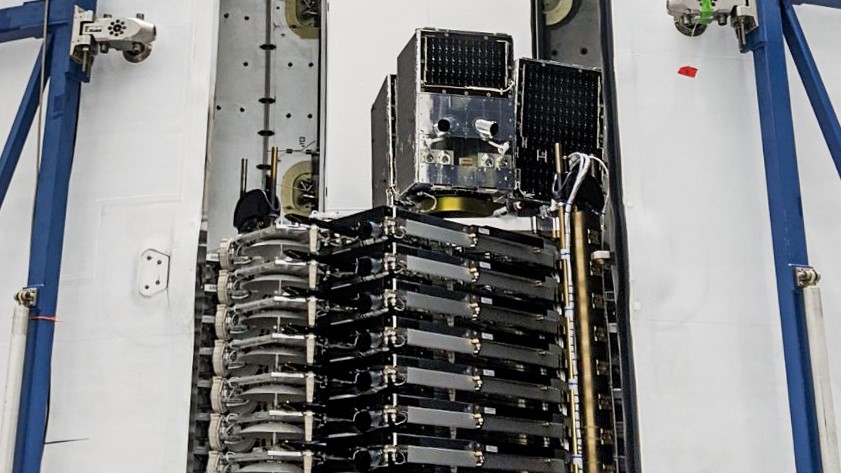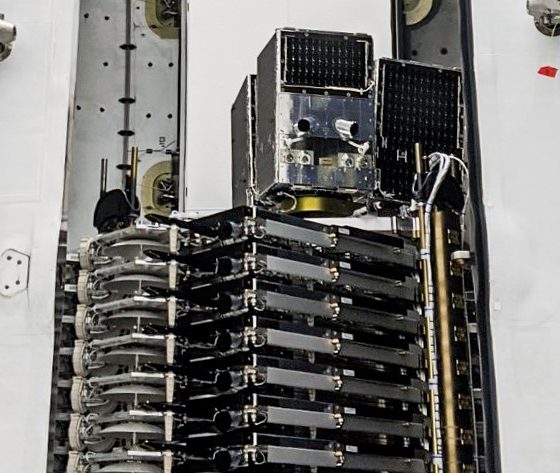

News
SpaceX Starlink rideshares to launch entire small satellite constellations
SpaceX is working with PredaSAR and Swarm Technologies to launch dozens of small satellites into orbit, contributing to Starlink Falcon 9 missions, according to reports.
PredaSAR signed a contract to launch a small satellite with the help of SpaceX on August 4. The two companies are still in talks to launch PredaSAR’s first constellation, made up for 48 satellites, with the help of the Elon Musk-headed aerospace company.
PredaSAR co-founder Mark Bell stated that his company and SpaceX have not yet finalized whether the satellites will be launched as a part of Starlink Falcon 9 missions, or if they will become apart of a separate rideshare launch, SpaceNews reported.
Synthetic aperture radar startup PredaSAR has signed a contract to launch a small satellite with SpaceX, and is in discussions to launch its entire first constellation with the company, PredaSAR co-founder Marc Bell, said Aug 4. https://t.co/Uw6yK6cEIe
— SpaceNews (@SpaceNews_Inc) August 5, 2020
“We agreed to do one, and we will negotiate the rest later,” Bell stated. He added that his company would like to work with SpaceX for the rest of its satellite launches, and believes an agreement will come “in the near future.”
PredaSAR has more satellites than the 48 it initially plans to launch, and will have a resolution well below one meter, Bell added.
In March, PredaSAR raised $25 million in funding for its constellation of satellites, which have both civilian and military benefits through imagery purposes.
SpaceX Vice President of Commerical Sales Tom Ochinero is excited about the partnership between the two companies. He said his company is “proud PredaSAR selected SpaceX as its launch provider for this very important mission.”
Meanwhile, Swarm Technologies is working with Exolaunch of Germany to launch 24 SpaceBee satellites into orbit on a Falcon 9 Starlink rideshare mission in December. Swarm received FCC approval for an internet servicing infrastructure with 150 SpaceBee satellites.
Exolaunch is expected to handle launch, integration, and deployment of SpaceBee satellites in sun-synchronous orbit, SpaceNews said.
In April, Exolaunch and SpaceX signed their first launch agreement together, which aimed to send satellites into orbit for the December Falcon 9 rideshare mission.
The December launch mission will integrate microsatellites and cubesats on a Falcon 9 Evolved Expendable Launch Vehicle Secondary Payload Adapter port. “Our team, experienced in handling large constellations of satellites, is ready to utilize its launch expertise and deployers to arrange the rides to space for Swarm aboard SpaceX’s Falcon 9,” Exolaunch Commercial Director Jeanne Medvedeva said.
On August 18, SpaceX successfully launched a new Starlink rideshare mission, where the two-stage Falcon 9 rocket carried 58 satellites. The Starlink satellites will contribute to SpaceX’s constellation, which will provide internet access across the world.

News
Tesla FSD fleet is nearing 7 billion total miles, including 2.5 billion city miles
As can be seen on Tesla’s official FSD webpage, vehicles equipped with the system have now navigated over 6.99 billion miles.

Tesla’s Full Self-Driving (Supervised) fleet is closing in on almost 7 billion total miles driven, as per data posted by the company on its official FSD webpage.
These figures hint at the massive scale of data fueling Tesla’s rapid FSD improvements, which have been quite notable as of late.
FSD mileage milestones
As can be seen on Tesla’s official FSD webpage, vehicles equipped with the system have now navigated over 6.99 billion miles. Tesla owner and avid FSD tester Whole Mars Catalog also shared a screenshot indicating that from the nearly 7 billion miles traveled by the FSD fleet, more than 2.5 billion miles were driven inside cities.
City miles are particularly valuable for complex urban scenarios like unprotected turns, pedestrian interactions, and traffic lights. This is also the difference-maker for FSD, as only complex solutions, such as Waymo’s self-driving taxis, operate similarly on inner-city streets. And even then, incidents such as the San Francisco blackouts have proven challenging for sensor-rich vehicles like Waymos.
Tesla’s data edge
Tesla has a number of advantages in the autonomous vehicle sector, one of which is the size of its fleet and the number of vehicles training FSD on real-world roads. Tesla’s nearly 7 billion FSD miles then allow the company to roll out updates that make its vehicles behave like they are being driven by experienced drivers, even if they are operating on their own.
So notable are Tesla’s improvements to FSD that NVIDIA Director of Robotics Jim Fan, after experiencing FSD v14, noted that the system is the first AI that passes what he described as a “Physical Turing Test.”
“Despite knowing exactly how robot learning works, I still find it magical watching the steering wheel turn by itself. First it feels surreal, next it becomes routine. Then, like the smartphone, taking it away actively hurts. This is how humanity gets rewired and glued to god-like technologies,” Fan wrote in a post on X.
News
Tesla starts showing how FSD will change lives in Europe
Local officials tested the system on narrow country roads and were impressed by FSD’s smooth, human-like driving, with some calling the service a game-changer for everyday life in areas that are far from urban centers.

Tesla has launched Europe’s first public shuttle service using Full Self-Driving (Supervised) in the rural Eifelkreis Bitburg-Prüm region of Germany, demonstrating how the technology can restore independence and mobility for people who struggle with limited transport options.
Local officials tested the system on narrow country roads and were impressed by FSD’s smooth, human-like driving, with some calling the service a game-changer for everyday life in areas that are far from urban centers.
Officials see real impact on rural residents
Arzfeld Mayor Johannes Kuhl and District Administrator Andreas Kruppert personally tested the Tesla shuttle service. This allowed them to see just how well FSD navigated winding lanes and rural roads confidently. Kruppert said, “Autonomous driving sounds like science fiction to many, but we simply see here that it works totally well in rural regions too.” Kuhl, for his part, also noted that FSD “feels like a very experienced driver.”
The pilot complements the area’s “Citizen Bus” program, which provides on-demand rides for elderly residents who can no longer drive themselves. Tesla Europe shared a video of a demonstration of the service, highlighting how FSD gives people their freedom back, even in places where public transport is not as prevalent.
What the Ministry for Economic Affairs and Transport says
Rhineland-Palatinate’s Minister Daniela Schmitt supported the project, praising the collaboration that made this “first of its kind in Europe” possible. As per the ministry, the rural rollout for the service shows FSD’s potential beyond major cities, and it delivers tangible benefits like grocery runs, doctor visits, and social connections for isolated residents.
“Reliable and flexible mobility is especially vital in rural areas. With the launch of a shuttle service using self-driving vehicles (FSD supervised) by Tesla in the Eifelkreis Bitburg-Prüm, an innovative pilot project is now getting underway that complements local community bus services. It is the first project of its kind in Europe.
“The result is a real gain for rural mobility: greater accessibility, more flexibility and tangible benefits for everyday life. A strong signal for innovation, cooperation and future-oriented mobility beyond urban centers,” the ministry wrote in a LinkedIn post.
News
Tesla China quietly posts Robotaxi-related job listing
Tesla China is currently seeking a Low Voltage Electrical Engineer to work on circuit board design for the company’s autonomous vehicles.

Tesla has posted a new job listing in Shanghai explicitly tied to its Robotaxi program, fueling speculation that the company is preparing to launch its dedicated autonomous ride-hailing service in China.
As noted in the listing, Tesla China is currently seeking a Low Voltage Electrical Engineer to work on circuit board design for the company’s autonomous vehicles.
Robotaxi-specific role
The listing, which was shared on social media platform X by industry watcher @tslaming, suggested that Tesla China is looking to fill the role urgently. The job listing itself specifically mentions that the person hired for the role will be working on the Low Voltage Hardware team, which would design the circuit boards that would serve as the nervous system of the Robotaxi.
Key tasks for the role, as indicated in the job listing, include collaboration with PCB layout, firmware, mechanical, program management, and validation teams, among other responsibilities. The role is based in Shanghai.
China Robotaxi launch
China represents a massive potential market for robotaxis, with its dense urban centers and supportive policies in select cities. Tesla has limited permission to roll out FSD in the country, though despite this, its vehicles have been hailed as among the best in the market when it comes to autonomous features. So far, at least, it appears that China supports Tesla’s FSD and Robotaxi rollout.
This was hinted at in November, when Tesla brought the Cybercab to the 8th China International Import Expo (CIIE) in Shanghai, marking the first time that the autonomous two-seater was brought to the Asia-Pacific region. The vehicle, despite not having a release date in China, received a significant amount of interest among the event’s attendees.








